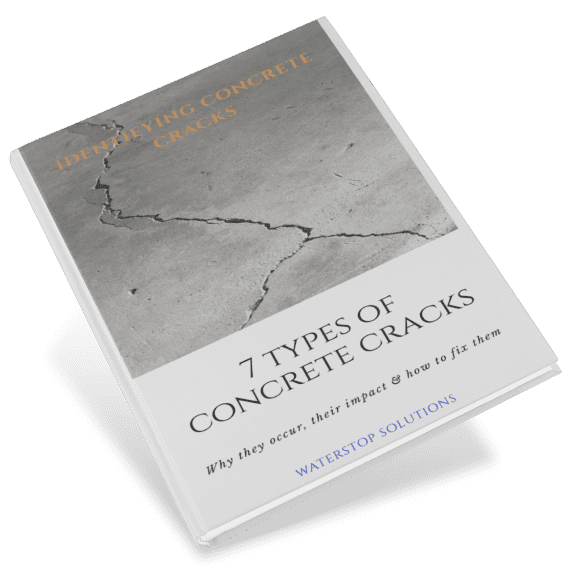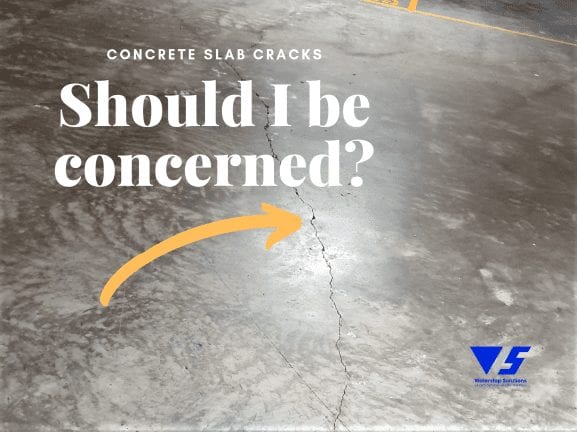
07 Jun IDENTIFYING CONCRETE CRACKS & HOW TO FIX THEM
If you have any questions regarding building defects such as cracked concrete, concrete deterioration and water ingress/seepage, we would love to hear from you!
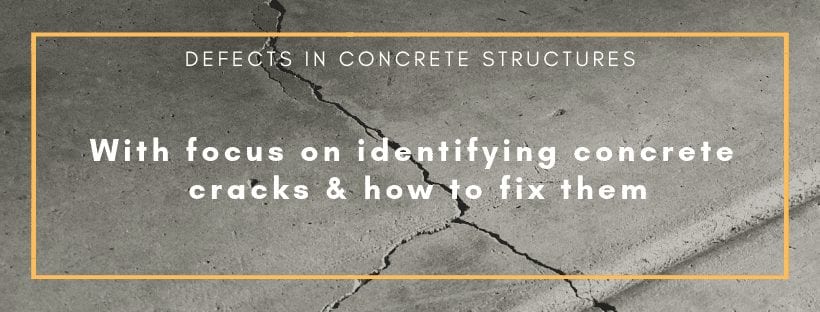
Defects in concrete structures – with focus on identifying concrete cracks and how to fix them
Defects in concrete structures can occur during and after construction and different types of defects can form for various reasons.
In this article, our focus is on identifying cracks in concrete. We discuss the 7 most common types of concrete cracks, why they occur, their impact and how to fix them.
Before we start discussing cracks in concrete, here is a short list of other common passageways for water ingress in concrete structures.
Defects in Concrete Structures
Cold joints
A cold joint is the point of connection where old and new concrete meet. It commonly occurs during construction when one batch of concrete has begun to set before the next batch is added. The old and the new concrete do not intermix and a so-called “cold joint” is formed as a result, creating a weakness in the concrete and a possible passageway for water intrusion.
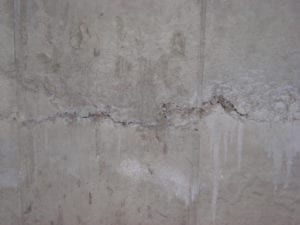
Cold joint – Where old and new concrete do not intermix.
Service lines and z-bar penetrations
Defects in concrete structures are commonly caused by penetrations through the concrete made for service lines or created by z-bars that are used for creating formwork ties or temporary tie-downs into the concrete.
Once the caps and bolts are removed, the z-bar holes are inserted with cement-based plugs or are patched with sand and cement mix. Pipe penetrations are also sealed with a cement-based plug or a patch from the interior side of the building during the original construction. The plug does not seal the gaps throughout the whole wall or slab and the bond to the concrete usually fails over time. This pathway allows water to find its way into the gaps and seeps through the concrete around the pipe penetration.
When a hole for the service pipe line is drilled through the concrete, the coring process can cause damage to the concrete structure by creating cracks. The core hole can often provide a direct path for water to pass through the concrete structure.
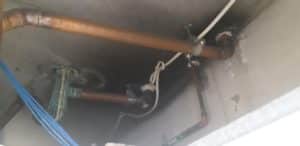
Pipe penetrations through concrete slab.
Bug holes / blow holes / bony areas / porous concrete
In these cases, there is too much air in the concrete, usually caused by improper vibration, non-permeable formwork and mix-design, for example insufficient fines to fill the voids between the aggregate.
Whether they are considered defects or not depends on the width and depth of the holes or gaps.
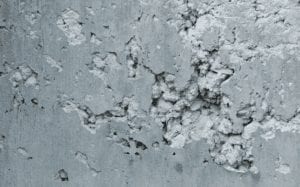
Consolidation related surface issues in concrete.
Construction joints
A construction joint is a break or gap between two slabs of concrete, where two successive slabs are joined together in a concrete structure. Construction joints are placed in the concrete at the time of placement with the help of dividing barriers of steel or plastic. Despite being a potential weak link that may cause serviceability problems, construction joints are in many situations a necessary requirement where there are multiple concrete placements.
Problems with construction joints arise frequently due to insufficient attention to design planning and their location. that may cause serviceability problems and lack of durability.
Control / contraction joints
Control joints are pre-planned and installed to prevent concrete cracking due to shrinkage during curing. A control joint is saw-cut into the curing concrete when the concrete is just hard enough, usually within 6-12 hours after the concrete has been poured. The timing depends on the concrete mix and the surrounding environment. The cuts should be made at a predetermined spacing, depth and pattern to meet structural engineering specifications and only after the concrete has obtained sufficient strength, but before internal cracking begins.
Cutting too early causes ravelling (pulling the aggregate out of position) and creates a weakened edge along the cut.
Cutting it too late results in uncontrolled cracking as shrinkage cracking has already begun during the hardening process of the concrete.
If the joint is cut too deep, the interlocking aggregate may not be sufficient to transfer loads and if the saw cut is shallow, then uncontrolled cracking may occur.
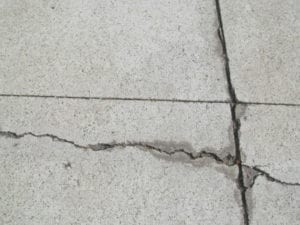
Crack formed outside control joints.
Expansion joints
An expansion joint is used in concrete to allow the concrete to absorb predicted movement by expanding or contracting with daily temperature variations. Lack of expansion joints may lead to uncontrolled cracking.
Deteriorating joint fillers and sealants leave the sidewall of the joint unprotected. If left untreated, joint spalling as well as water and other material ingress can result in decreased service life of the concrete structure.
Identifying cracks & how to fix them
Types, Causes, Prevention and Repairs
You see a crack in the concrete slab or wall and you wonder: Should I be concerned? Could this be a structural issue or just an aesthetic concern?
Concrete cracks are very common and they occur for various reasons. In this article we talk about the 7 most common types of cracks, their causes and how to remedy them.
We present here a general guide to help discover whether the concrete cracks that you see could
be an issue or merely an aesthetic problem.
Rest assured that even with the best floor design and proper construction, concrete cracks are very common and, in some situations, inevitable. Fortunately, they can usually be repaired.
Generally speaking, most types of cracks do not affect structural stability or durability.
However, identifying the status of a crack is critically important. This will help determine what kind of repairs are required, if any.
Cracks in concrete are of common occurrence and they develop when stresses in the concrete exceed its strength. Cracks are often caused by normal shrinkage of the concrete when hardening and drying. Concrete cracks can range from being a non-structural and unsightly, to being detrimental to the structural integrity and safety of a building.
As a general recommendation, cracks are best remediated at an early stage to help protect the integrity and longevity of an asset.
The object of any repair is to improve the durability and wear of a surface, reduce its permeability and to prevent the development of a corrosive environment for the reinforcement steel. The goal is to ensure that the long-term integrity of the concrete elements is not compromised.
The 7 Most Common Types of Concrete Cracks
Why they occur, their impact & how to fix them
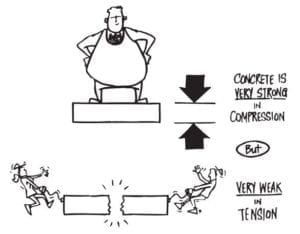
Concrete is strong in compression but weak in tension.
An exothermic chemical reaction kicks in as soon as the concrete mix has been poured, which creates heat and thereby the evaporation of water. When the water molecules evaporate from the concrete mass, they leave voids behind. This drying process leads to stresses and strains, which means that during the curing process it creates movements that result in so-called “drying shrinkage cracks”.
Water is lost from the concrete mass in two main ways:
- Drying from the top: Moisture rises to the top surface of a concrete element during placement – a process known as bleeding. Bleed water dries out mainly from evaporation; when the rate of evaporation exceeds the rate of bleeding, the surface dries and tends to crack.
- Drying from the base: Water in a concrete slab may be absorbed into the subgrade or ground below. In addition to affecting bleeding this could significantly increase settlement of concrete and the risk of associated cracking.
Cracks are classified as structural and non-structural.
Structural cracks may endanger the safety and durability of a building. They can form due to incorrect design, faulty construction and/or overloading. Non-structural cracks are mostly formed due to internally induced stress in building materials and do not result in weakening of the structure. However, if left untreated, a non-structural crack may facilitate ingress of moisture and other destructive environmental substances which may lead to corrosion of reinforcement, making the concrete structure unsafe.
Cracks that are identified as small and fine (less than 0.3 mm in width), are generally deemed acceptable as part of minor settlement depending on the purpose and intent of the concrete structure, the environment it is placed in, the design-life and the durability design. Nevertheless, a qualified and licenced professional should be consulted to classify the severity of the crack and appropriately investigate the cause of the crack and determine the most effective repair method if required.
The most common types of cracks are organised in the following 7 groups1) Plastic Settlement2) Plastic Shrinkage3) Early Thermal Contraction4) Long-term Drying Shrinkage5) Crazing6) Corrosion of Reinforcement7) Alkali-aggregate Reaction
|
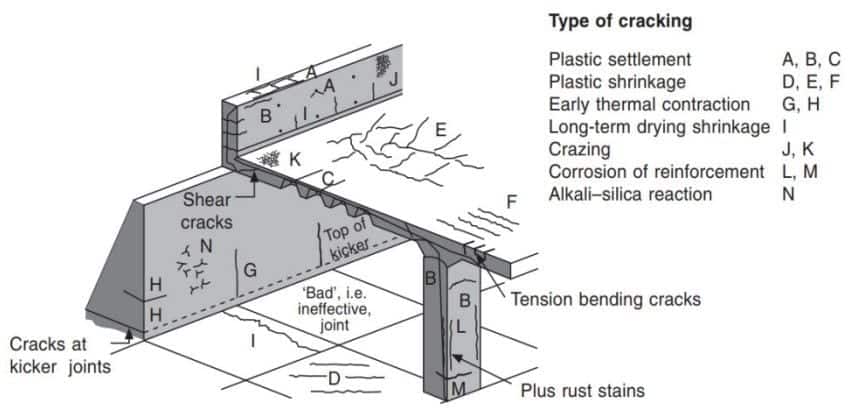
7 Types of cracking – common places where cracking occurs.
1. Plastic Settlement
Position on diagram: A, B and C
Plastic settlement cracks form while the concrete is still plastic, during the initial setting of concrete. At this time, bleed water is still rising and it covers the surface while the aggregate and cement settle under the force of gravity. This separation forms a weaker layer of concrete near the surface. These types of cracks occur on the surface before the concrete has set. Plastic settlement cracks are typically mirroring the pattern of the restraining elements such as reinforcements.
Plastic settlement cracks are often identified in deep section pours, such as on top of beams and columns. Waffle slabs – where there are changes of depths – are also prone to plastic settlement cracks.
What is the impact of plastic settlement?
Plastic settlement cracking that is identified as small and fine (less than 1mm in width), is generally deemed acceptable as part of minor settlement. However, a qualified and licenced professional should be consulted to classify the severity of the crack and appropriately investigate the cause of the crack and determine the most effective repair method if required.
Occasionally, some plastic settlement cracks can be wide at the surface and may extend to the reinforcement steel or other types of restraining elements. This may expose the reinforcement steel to the elements and increase the risk of corrosion and thereby pose a threat to the durability of the concrete slab. Further drying shrinkage can potentially lead to full depth cracking of the concrete slab.
How can plastic settlement cracks be fixed?
In pre-hardened concrete: Re-vibration or mechanical re-trowelling of the surface are the most effective methods of repair – closing the cracks shortly after they have formed.
In hardened concrete: Cracks may be v-cut with a concrete crack chaser and filled with suitable material. This is the best method to help improve the durability of the surface and prevent a corrosive environment developing around the reinforcement.
Depending on the depth and/or width of the crack, certain concrete cracks may best be repaired by targeted injection of appropriate material tailored to the individual crack’s diagnosis, followed by a suitable protective concrete coating.
The goal is to ensure that the long-term integrity of the concrete elements is not compromised.
How can plastic settlement cracks be minimised?
- A good quality concrete mix with shrinkage-compensating cements (air entrapment).
- Ensure that the concrete is fully compacted and vibrated.
- Increase the cover of concrete to reinforcement steel to minimise the likelihood of cracks forming at the surface.
- For footings, wetting the soil prior to the pour avoids excessive water loss from the base of the concrete.
- Ensuring that the formwork around the slab is rigid during placement.
- Placing the concrete in deep sections first, such as beams and columns, reduces the likelihood of differential settlement. As a general rule, depending on weather conditions, the new concrete placement is advised to be poured less than 45 minutes against concrete previously placed. Otherwise, the development of cold joints may occur.
2. Plastic Shrinkage
Position on diagram: D, E and F
Plastic shrinkage cracks form due to rapid early drying and a low rate of bleeding while the concrete is still plastic (not set). Plastic shrinkage occurs mainly in concrete elements with a high surface to volume rate, such as slabs and pavements. Air and concrete temperature, wind speed, the warming and drying action and relative humidity all play an important role in the rate of moisture evaporation from setting concrete. Plastic shrinkage cracking occurs when the rate of evaporation from the surface exceeds the rate at which moisture is being supplied to it (via bleeding from the concrete).
Rapid drying of the surface of the concrete causes it to shrink and crack (similar to the cracking that occurs in clay soil as it dries). The cracks are not always evident and may not be discovered until the next day.
Plastic shrinkage cracks may form in a random pattern or they can appear in an almost parallel pattern. The cracks are often almost straight, ranging in length from 25 mm to 2 m but are usually 300 to 600 mm long. They can range from 1 to 3 mm wide at the surface and are superficial.
What is the impact of plastic impact shrinkage cracking?
The cracks usually do not extend to the perimeter of a slab and it rarely impairs the strength of a concrete element. They normally only impact on the aesthetic appearance of the concrete.
However, it is important to keep a close eye on these cracks as they can potentially form a weakness in the concrete. With subsequent drying shrinkage, thermal movement and/or loading, the cracks can be deepened, widened and/or extended, which may eventually cause a crack to penetrate right through the concrete element. This crack may lead to water ingress problems since it can start acting as a passageway for moisture and dissolved salts. This issue can lead to rusting reinforcement steel, concrete deterioration and spalling if left untreated.
How can plastic shrinkage be fixed?
In pre-hardened concrete: While the concrete is still plastic, the surface can be worked with surface vibrators to close the cracks whilst ensuring that the concrete re-liquifies so that the cracks close fully.
In hardened concrete: Where they are of concern for watertightness and/or protection of the reinforcement steel, or the cracks are 2 mm or wider, the cracks should be filled with a suitable proprietary filler. The cracks may be v-cut with a concrete crack chaser and filled with suitable material.
Depending on the depth and/or width of the crack, certain concrete cracks may best be repaired by targeted injection of appropriate material tailored to the individual crack’s diagnosis followed by a suitable protective concrete coating. Again, the goal is to preserve the long-term integrity of the concrete elements.
How can plastic shrinkage cracking be minimised?
Controlling the evaporation rate of the drying surface is the number one key to avoiding plastic shrinkage cracking.
- Dampen the substrate and formwork and remove any excess water prior to placing the concrete.
- Use of sufficient quantity of synthetic of steel fibres in the concrete to help offset the effect of plastic shrinkage.
- In hot weather, lower the temperature of the fresh concrete by using chilled mixing water or replacing some of this water with crushed ice.
- Install wind brakes.
- Immediately after screeding the concrete, apply aliphatic alcohol over the surface. This water-based finishing compound effectively controls the evaporation of bleed water.
3. Early Thermal Contraction
Position on diagram: G and H
Cracking due to early age thermal contraction can appear in large concrete sections due to excess heat generation in thick concrete walls and excess temperature gradients in thick concrete slabs.
Early thermal contraction cracks are common in cantilever walls often used in reservoirs, dams, concrete tanks, retaining walls, bridge abutments and basements. They are also common in other large pours that exceed 2 meters, such as pavements.
One of the major reasons of cracking in early age concrete are the volume changes due to the temperature and the moisture variations during the hardening process.
Thermal cracking occurs when the temperatures of different portions within a concrete slab exceed a certain limit. These temperature variances exist because the internal temperature of the concrete slab rises and drops slowly – due to concrete’s exothermic reaction – while the peripheral temperature of the slab cools rapidly due to the ambient temperature.
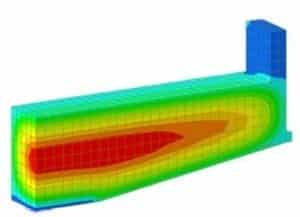
Internal temperature versus peripheral temperature of a concrete element.
Excessive temperature difference within a concrete structure or its immediate environment causes the cooler portion of the concrete to contract more than the warmer portion. This leads to stresses greater than the tensile strength of the concrete and early thermal cracks appear.
Changes in ambient temperature conditions from moderate day-time temperature to low night-time temperature may cause rapid cooling of the exposed surface of the concrete and the contraction is likely to cause thermal cracking.
If concrete is free to contract without restraint, thermal cracking will not occur. However, there is always some internal and external restraint. One example of an external restraint is where concrete is cast onto a previously hardened base, or adjacent to similar elements, without the provision of an expansion joint. The internal restraint is the warm interior of the concrete, which will contract later as it cools. Depending on the temperature difference and the strain capacity of the concrete, differential thermal strains may cause the concrete to form early thermal contraction cracks.
What is the impact of early thermal contraction?
Unless the structural tolerance level is exceeded, early-age cracking formed by early thermal contraction are not considered to affect the general safety of the concrete structures. That being said, the aesthetic appearance may be greatly affected if the cracks are not repaired. Furthermore, if the cracks are left untreated, they may lead to ingress of water, oxygen and minerals, which may bring on the corrosion of reinforcement steel, costly maintenance and potential durability issues.
Whilst early-age cracking may initially be considered as a minor shortcoming, it is advised that building owners and building maintenance managers appoint qualified remedial repair contractors to correctly repair these cracks sooner rather than later in order to help prolong the service life of the concrete structures.
Structures such as concrete dams, reservoirs, tanks and roofs are especially at risk. If early-age cracks are left to further develop, it may affect the bearing capacity of the structure and speed up fatigue failure.
Leakage in concrete structures, can also lead to deterioration of other building assets.
How can early thermal contraction cracks be fixed?
In hardened concrete:
Cracks are best to remediate at an early stage to help protect the integrity and longevity of the asset.
Depending on the depth and/or width of the crack, a crack can be v-cut with a concrete crack chaser and filled with suitable material. Certain concrete cracks may best be repaired by targeted injection of appropriate material tailored to the individual crack’s diagnosis followed by a suitable protective concrete coating.
The object of the repair being to improve the durability and wear of the surface, watertightness and prevent the development of a corrosive environment for the reinforcement. The goal is to ensure that the long-term integrity of the concrete elements is not compromised.
How can early thermal contraction cracks be minimised?
In many situations, early thermal contraction cracking cannot be avoided, but it can be reduced by avoiding excessive heat of hydration, reducing restraint where possible and using an adequate quantity and distribution of reinforcement.
- Proper selection of materials and mix design
- Planning the pour sizes, segmental concreting, dimension and geometry of the concrete structure and construction sequence
- Consider the environmental conditions, such as ambient temperature, temperature of neighbouring elements, wind and humidity
- Reduce the heat by cooling the concrete before placement
- Insulate to reduce thermal gradients
- Install expansion joints early where applicable
- Provide reinforcement steel at optimum spacing in order to control crack width.
4. Long-term Drying Shrinkage
Position on diagram: I
The most common locations where long-term drying shrinkages occur are in thin floor slabs and walls, typically along an ineffective joint.
Long-term shrinkage in concrete depends on number of factors, e.g. Cement and water content, size of aggregates and aggregate-cement ratio, spacing of reinforcement steel, excessive fines, use of admixtures, composition of cement, temperature, humidity and inefficient curing.
The primary cause of long-term drying shrinkage is due to inefficient joints.
What is the impact of long-term drying shrinkage?
The volume reduction in concrete that occurs primarily due to moisture loss after the concrete has hardened is known as drying shrinkage. The ratio of water to the amount and type of aggregate and the cement paste are the main influences on the amount of drying shrinkage. To minimise the amount of shrinkage it is best to use stiff aggregate in high volumes relative to the cement paste because the rate of shrinkage increases with the volume of cement.
A higher ratio of water to cement increases the level of shrinkage due to the volume loss when the water evaporates, so reducing the water content in the concrete mix will help improve the curing. To minimise drying shrinkage, the total water content of the concrete mix should be kept as low as possible for the intended application.
Efficient curing plays an important role in limiting shrinkage. If proper curing is started as soon as initial set has taken place and is continued for at least 7-10 days, the risk of drying shrinkage can be reduced. When concrete is hardening in a humid environment initially, there will be some expansion which offsets a part of subsequent shrinkage.
How can long-term drying shrinkage cracks be fixed?
In hardened concrete:
Depending on the depth and/or width of the crack, a crack can be v-cut with a concrete crack chaser and filled with suitable material. Certain concrete cracks may best be repaired by targeted injection of appropriate material tailored to the individual crack’s diagnosis followed by a suitable protective concrete coating.
How can long-term shrinkage be minimised?
- Reduce water content to improve curing.
- Use concrete with workability as low as possible.
- Use admixtures formulated for hydration workability to compensate for reduced water content.
- Avoid using admixtures containing calcium chloride as they are known to increase drying shrinkage.
- Use of shrinkage-compensating admixture or crack-reducing admixture will improve the cracking resistance and reduce the rate of drying shrinkage cracks.
- Use highest possible of hard, rigid aggregate content and a smaller content of cement. A greater volume of stiff aggregate reduces concrete shrinkage because the aggregate provides restraints.
- Eliminate external restraints as much as possible by providing expansion joints wherever applicable.
- Provide reinforcement steel at optimum spacing in order to control crack width.
5. Crazing
Position on diagram: J and K
Crazing is the development of fine random cracks on the surface of the concrete caused by shrinkage of the surface layer. Crazing is caused by drying out of the concrete surface, particularly when the surface has been exposed to low humidity, high air or concrete temperature or hot sun during placement for the concrete mix.
The cracks are typically shaped like irregular hexagon patterns not more than 50 to 100 mm across. They are rarely more than 3 millimetres deep and are more noticeable on overfloated or steel-trowelled surfaces.
The most common areas susceptible to crazing are against impermeable formwork on “fair-faced” concrete and/or where rich mixes have been used. Crazing is also found on floated concrete slabs due to over-trowelling and/or poor curing.
Apart from appearance, crazing cracks do not usually affect the structural integrity of the concrete, but may lead to subsequent deterioration of the concrete.
What is the impact of crazing?
Many craze cracks are not visible until the surface gets wet and starts to dry. Apart from appearance, crazing cracks do not affect the strength or durability of the concrete to a great degree as long as water intrusion is not occurring, which may on lead to subsequent deterioration of the concrete.
How can crazing be fixed?
In hardened concrete:
A protective coating such as epoxy, dry-look “invisible” penetrative water repellent coating or other types of high-performance re-surfacing products can be applied to rectify the appearance of the concrete surface and help enhance the service life.
How can crazing minimised?
- To produce high quality concrete and to minimise crazing, start curing the concrete as soon as possible. Improve the curing and finishing. A continuous supply of moisture in concrete will help to prevent the appearance of crazing on the concrete surface.
- The surface should be kept wet by either flooding with water or covering with a moisture retaining cover, such as a wet burlap curing blanket, and keeping the concrete moist for a minimum of 3 days.
- Use air-entrained concrete that is designed to produce the required strength without excessive bleeding and segregation.
- Use low slump concrete because higher slump concrete may result in segregation, which again may result in a weak surface layer.
- Air entrainment helps to reduce the rate of bleeding of fresh concrete and thereby reduces the chance of crazing.
- Avoid steep moisture difference between concrete surface and the interior of the concrete.
- Avoid using rich finishing mixes, not richer than 1:3.
- Do not sprinkle or trowel dry cement or mixture of cement and fine sand into the surface of the plastic concrete to absorb bleed water. Bleed water can be removed by dragging a garden hose across the surface.
- Do not perform any finishing operation while bleed water is present on the surface
6. Corrosion of Reinforcement
Position on diagram: L and M
Common locations
One of the most common locations one can find corrosion of reinforcement are in columns and beams with the primary cause being lack of concrete cover to protect the reinforcement and/or poor-quality concrete.
Corroding reinforcement is also commonly found in older precast concrete where excess calcium chloride has been added to the concrete mix to accelerate the hardening of the concrete.
When concrete is reinforced with the tension strength that reinforcing steel rods provide, the composite material resists not only compression, but also bending and other tensile actions.
The high pH (alkalinity) of concrete forms a passive film on the surface of the embedded reinforcing steel rods and acts as a protective shield that prevents or minimises corrosion. Reduction of the concrete’s pH by carbonation or the ingress of chlorides (salt), which are the most common causes of concrete corrosion, causes the steel’s passive film to degrade. Rust begins to form on the unprotected reinforcing steel.
The build-up of corrosion causes tensile stresses as it grows in thickness. The pressure causes the concrete to form cracks near the steel that will with time lead to more extensive cracking as the rust builds up until the concrete starts to break away from the reinforcing steel bars (spalling of concrete) and expose the corroded reinforcing steel rods.
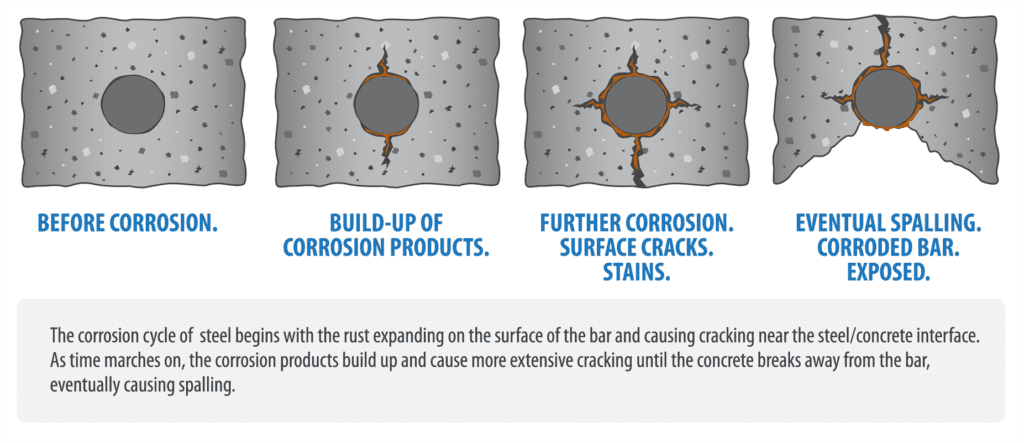
Corrosion cycle of steel reinforcement in concrete.
Reinforced concrete structures degrade with time and exposure to the environment, particularly if that environment contains salts.
Reduction of the concrete’s alkalinity either by carbonation or by the ingress of chlorides (salts) are the most common causes of concrete corrosion.
Three conditions must exist for reinforcing steel to corrode:
- The passivation of the steel must have been destroyed by chlorides or by carbonation
- The presence of moisture as an electrolyte
- The presence of oxygen
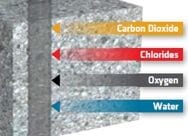
Chloride ions
Exposure of reinforced concrete to chloride ions (salts in air and water) is the primary cause of premature corrosion of steel reinforcement. The intrusion of chloride ions, present in airborne salts and seawater, into reinforced concrete can cause the steel to corrode if oxygen and moisture are also available to sustain the reaction. Chlorides dissolved in water can permeate through sound concrete or reach the steel through cracks. The alkaline protection provided by the concrete to the steel breaks down, promoting the corrosion.
Chloride-containing admixtures may also cause corrosion.
Carbonation
Carbonation is a slow acting process that can result in rusting reinforcement. Carbonation occurs when carbon dioxide from the air penetrates the concrete and reacts with hydroxides, such as calcium hydroxide, to form calcium carbonates in presence of water. The reduced pH value starts breaking down the passivation film of concrete, which leads to corrosion of the reinforcing steel.
Carbonation-induced corrosion often occurs on areas of building facades that are exposed to rainfall, shaded from sunlight, and have low concrete cover over the reinforcing steel.

What is the impact of corrosion of reinforcement?
Corrosion of reinforcing steel and other embedded metals is by far the leading cause of premature ageing, deterioration and durability issues in concrete.
For reinforcing steel to corrode, the passive oxide layer on the steel must fail. If the concrete cover that protects the reinforcing steel is damaged and the bond between the concrete and steel reinforcement bar is broken, the steel’s passive layer will break down and active corrosion of the steel will start.
When steel corrodes, the resulting rust occupies a greater volume than the steel. The corroding steel reinforcing bars can expand to eight (8) times the volume of the original steel. This expansion creates tensile stresses in the concrete, damaging the surrounding concrete causing development of cracks, delamination, and spalling.
The corrosion of reinforcement steel leads to a reduced resistance of the steel bars, which depending on severity, may negatively affect the load-bearing capacity and service life of the concrete.
There are two safety concerns to consider if corrosion is present and left untreated for a long time:
- Loose concrete falling onto pedestrians, vehicles and other assets.
- Risk of collapse due to reduction in load-carrying capacity.
How can corrosion of reinforcement be fixed?
A typical method of concrete repair process:
- Break out unsound concrete and expose reinforcing steel until sound concrete is found and clean non-corroded reinforcing steel.
- Saw cut repair zone perimeter to eliminate feather edges.
- Chisel away the concrete around the reinforcing steel. Prepare substrates – including the removal of any corrosion. Reinstate reinforcing steel and/or add more as deemed necessary.
- After completion of material removal, a concrete primer and rust inhibitor are applied to the steel prior to reinstating with a high build shrinkage compensated repair mortar. Formwork may be erected to close the cavity prior to installing the repair products.
- Our recommendation is that the treatment of concrete cancer should incorporate a proper weather/waterproofing system as part of a complete solution, or it risks compromising the life of the repair solution as the underlying cause is likely to continue to affect the structure, depending on the situation.
How can corrosion of reinforcement be minimised?
- The first defence against corrosion of reinforcement is to properly compact the concrete around the reinforcing steel with quality concrete in a thick layer.
- Reinforcing bars and mesh should be located so that there is enough room between the bars to place and compact the concrete.
- Create a strong bond between the concrete and reinforcement. This allows the tensile forces to be transferred to the reinforcement, thus reducing the width of cracking.
- To help achieve a strong bond, the reinforcing steel should be clean, free from flaky rust, dirt and grease.
- Minimize the water-cement ratio, compact and cure the concrete well. The lower the water-to-cement ratio, the lower the permeability of the concrete. Concrete with low permeability is better able to resist the penetration of water.
- To help protect the concrete against corrosion, apply a quality protective coating system to the finished surface to prevent water from entering the concrete and maintain joint seals.
7. Alkali-Aggregate Reaction (AAR)
Position on diagram: N
Alkali–Aggregate Reaction refers to a destructive expansion reaction within the concrete which occurs over a long period of time (more than 5 years) in concrete. There are three conditions that all must be present to promote AAR, and those are: Reactive silica in the aggregate, significant alkalinity and moisture.
Alkali-Aggregate Reaction (AAR) has two forms:
- Alkali-Silica Reaction (ASR)
- Alkali-Carbonate Reaction (ACR)
ASR is the most common form of Alkali-Aggregate Reaction (AAR) in concrete.
Alkali-Carbonate Reaction (ACR)
Alkali-Carbonate Reaction (ACR) is a very rare occurrence in concrete. When Alkali-Carbonate Reaction (ACR) does occur in concrete, it is due to the result of recrystallization of dolomite rock or dolomitic limestone, which are associated with expansion causing the concrete to deteriorate.
The use of aggregates of certain dolomitic rocks is normally avoided due to it being unsuitable as aggregate in concrete for other reasons than alkali-carbonate reaction.
Alkali-Silica Reaction (ASR)
Some aggregates that contain silica in a glassy form (non-crystalline silicon dioxide) react with the alkali hydroxides present in concrete. When non-crystalline silicon dioxide (which originate mainly from the Portland Cement) reacts with alkali hydroxide in the concrete or alkalis present in the environment such as sea spray or groundwater, the reaction forms an alkali-silicate gel that swells as it absorbs moisture from the surrounding cement pore solution in the concrete or from the environment. Over time, the expansion of the gel causes the concrete to crack. This expansion process may take from 5 – 20 years before cracking eventually leads to failure of the concrete structure.

Alkali-Silica Reaction – ASR cracking of concrete.
Alkali-Silica Reactions (ASR) in concrete takes place between the highly alkaline cement paste and non-crystalline silicon dioxide, which is found present in some aggregates typically used in the USA and Canada.
ASR is not as common in Australia, although ASR has been reported in parts of Australia from Perth to North Queensland, Victoria and Southern Tasmania in wharves, bridges, reservoirs and other structures, particularly in structures where high strength concrete was used. The thought is that in high-strength concrete, moisture is more likely to be retained in the concrete and because there are less internal voids for the alkali-silica gel to expand, the expansion is more likely to cause cracking.
The most common locations Alkali-Silica Reactions (ASR) occur, are in damp locations, because sufficient moisture must be present for the reaction to take place.
Typical areas where Alkali-Silica Reaction (ASR) occur is where concrete structures such as piers and bridges that are close to the waterline or in a body or water. Other common areas are retaining walls, dams, near joints and edges in pavements, highway structures, median barriers or columns that are subject to capillary action.
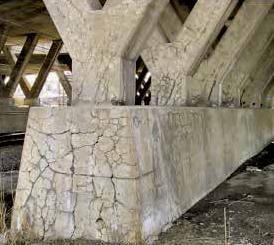
Alkali-Aggregate Reaction – ASR cracking of concrete bridge.
What is the impact of Alkali-Aggregate Reaction?
Deterioration of concrete structures due to Alkali-Aggregate Reaction (AAR) is not prevalent in Australia. However, cracking concrete bridges in North-Queensland have been identified as being caused by Alkali-Silica Reactivity (ASR), as well as a dam in Victoria and a bridge in Perth.
Alkali-Silica Reactivity (ASR) is a durability problem that can result in premature deterioration of concrete structures. The reaction-caused swelling gradually leads the concrete to crack. Continuous expansion can induce serious cracking which may lead to major structural problems in the future.
How can Alkali-Aggregate Reaction be fixed?
Once AAR has started, it is very difficult to stop whilst moisture is still present.
Very few methods are available to mitigate further damage in concrete structures already affected by ASR-induced expansion and cracking, but there are some methods that have shown some success in slowing down the ongoing ASR.
To help prolong the service life of the concrete structure and to slow down the effects of ASR we recommend the following methods:
- Repair existing cracks to minimize future expansion and avoid ingress of moisture
- Seal leaks
- Apply appropriate waterproofing sealer or coating to limit water ingress and to help reduce the internal humidity of the concrete structure and thereby reducing the expansion of the structure elements
- Provide effective drainage
- Repair or replace ASR affected concrete and affected structure where appropriate
- Application of Carbon Fibre Reinforced Polymer (CFRP) composite has shown some promising effects on structural strengthening ASR damaged concrete. (Ref. studies carried out by USQ University of South Queensland)
- Estimate the cost of repair and compare with estimated remaining service life after repair is recommended
How can Alkali-Aggregate Reaction be minimised?
- It is recommended that Alkali-Carbonate Reaction (ACR) susceptible aggregates not be used in concrete.
- Alkali-Silica Reaction (ASR) can be controlled using certain supplementary cementitious materials.
- Use low-alkali Portland cement or incorporate pozzolan into concrete mixes.
- The use of pozzolans in the concrete mix as a partial cement replacement can reduce the likelihood of ASR occurring as they reduce the alkalinity.
- Add supplementary cementitious materials such as, fly ash, slag, or silica fume; or lithium admixtures.
- To help protect the concrete structure, apply a quality protective coating and joint sealing system to the finished surface.
Repair of Shrinkage Cracks
Successful long-term repair procedures must address the causes of the cracks as well as the cracks themselves.
Repairs to concrete structures should be undertaken with the advice of a qualified and licenced professional. Inappropriate repair techniques may result in greater damage later. Repair of mass concrete structures will depend on the crack width, depth, if it is dormant or live and the service conditions of the structure.
Cracks that are identified as small and fine (less than 0.3 mm in width), are generally deemed acceptable as part of minor settlement. However, a crack should be inspected and diagnosed to classify the severity of the crack, the cause of the crack, if it is a dormant or a live crack in order to determine the most effective repair method.
Cracks that are 0.3 mm or greater pose an issue for durability and watertightness.
The desired outcome of concrete crack repairs
Once the cause and significance of the concrete cracking has been diagnosed by a qualified and licenced inspector, it is important that accurate repair methods are followed. The selected repair methods are based on an evaluation of the crack and the repair’s objective(s).
Concrete crack repair objectives:
- Restoring or increasing strength and durability
- Maintaining and improving the concrete structure’s service life by using high performing quality products to improve density, abrasion, chemical and acid resistance
- Improving functional performance
- Providing watertightness
- Improving the concrete surface’s appearance
- Preventing the development of a corrosive environment for the reinforcement
Repairs before hardening of concrete
The Plastic shrinkage/Plastic Settlement may be repaired in plastic state by reworking the concrete surface using surface vibrators to close the cracks over their full depth and then completed by surface finishing. Careful timing is essential to ensure the concrete re-liquefies under the action of the vibrator and that the cracks close fully. If only re-trowelling is done, it may just form a skin (which can fracture with subsequent shrinkage, thermal or traffic impacts) over the cracks but not close them.
Repairs after hardening of concrete
The key to successful crack repairs is having an understanding of the causes of the cracking and also whether the cracks are dormant or active.
Repair of Dormant cracks – Dormant cracks are stable and future movements are not anticipated or in other words, unlikely to open, close or extend further. Cracking caused by drying shrinkage and thermal shrinkage will be active cracks at the beginning but may eventually stabilise and become dormant.
Fine hairline cracks may not need any repairs however, these cracks may prove to be a future durability problem. We recommend sealing them by installing a bonded overlay or surface treatment as a protective coating. (If the fine crack is non-dormant, we would recommend v-cutting it and seal it with appropriate sealant material to accommodate for the potential movement). These treatments will aid in protecting the concrete from water ingress and other destructive environmental influences.
Wider cracks may be sealed by epoxy, polyurethane or acrylic resins followed by a protective coating or membrane.
Repair of Active/Non-dormant cracks: – Active/dynamic/live concrete cracks are expected to experience further movement and growth. The cracks may be resulting from continuous foundation settlement or the cracks are acting as contraction and expansion joints.
These cracks should be treated as if they are the moving joints and the repair should cater for the anticipated potential movement. V-cutting along the line of the crack and then sealing it with appropriate sealant material will allow movement and protect against further expansion of the crack and possible water ingress.
Active/dynamic/live cracks can effectively be repaired with high-pressure polyurethane injection, which may be followed by installation of a joint-seal and protective coating or membrane.
Concrete Crack Injection Repair
When to use Epoxy
Depending on the specific requirements of the job, crack repair by epoxy injection can restore structural integrity and reduce water penetration through concrete cracks that measure 0.05 mm in width or greater.
Low viscosity epoxy resin is mainly used for structural crack repair when future movements are not anticipated (dormant cracks). If a crack is subject to subsequent movement, a repair with an epoxy resin may not be suitable.
Another thing to consider is that epoxy resins can have difficulties in setting and developing into the desired strength if there is presence of water, unless the epoxy resin is designed to tolerate water during the curing process.
When to use Polyurethane
Polyurethane resins are excellent to seal wet and leaking cracks and cracks that are non-dormant/active cracks. This repair option is used to stop water leaks and consists of injecting a highly water reactive resin into cracks under pressure. The product reacts rapidly with the water, chasing the water present in the crack and begins to foam and expand, filling the entire crack resulting in a strong bond with the concrete and a flexible waterproof seal preventing future water leaks. This repair is a permanent repair and works with either active or dormant cracks. The benefit of polyurethane crack injection is that it is strong and it provides some flexibility for crack movement.
Conclusion
Cracks in concrete are common and they develop when stresses in the concrete exceed its strength. Cracks are often caused by normal shrinkage of the concrete when hardening and drying. Concrete cracks can range from being a non-structural and unsightly crack to being detrimental to the structural integrity and safety of a building.
Generally speaking, while most types of cracks do not affect the structural stability or durability, a crack’s status identification is critically important. Identifying what type of crack it is, and how it occurred, will help determine what repairs are required.
Non-structural cracks do not impact on the integrity and strength of the concrete structure, but affect the aesthetics of the structure. Nevertheless, if left untreated, they have the potential to develop into a problem as they can act as a passageway for the penetration of materials into the concrete structure. Cracks that are 0.3 mm or greater pose an issue for durability and watertightness. This can eventuate into concrete deterioration, affecting its strength and durability.
In this article, we have discussed the types of shrinkages, resultant cracks, preventative measures and repair methods. The selection and use of suitable materials with good construction practices reduce the occurrence of shrinkage and resultant cracks, thus enhancing the service life and reducing the life cycle cost of concrete structures.
For recommendations on crack repair methods, detailed preparation and application guidelines and application, please contact Waterstop Solutions for relevant information and site inspection. Contact us
Brisbane office: (07) 3205 1899 email: [email protected]
Sydney office: 02 9346 8308 email: [email protected]
Statement of responsibility: Waterstop Solutions offers this document as a brief review of causes and characteristics of concrete cracks as a standard guide for evaluating cracks in concrete. It remains the responsibility of the engineer, building inspector or client to determine the correct methods of evaluation. The technical and application advice given in this publication is based on the present state of our best knowledge as the information in this document is of general nature.
For recommendation on crack repair methods, concrete surface protective coatings, preparation details and application guidelines, please contact Waterstop Solutions for relevant information and site inspection.


